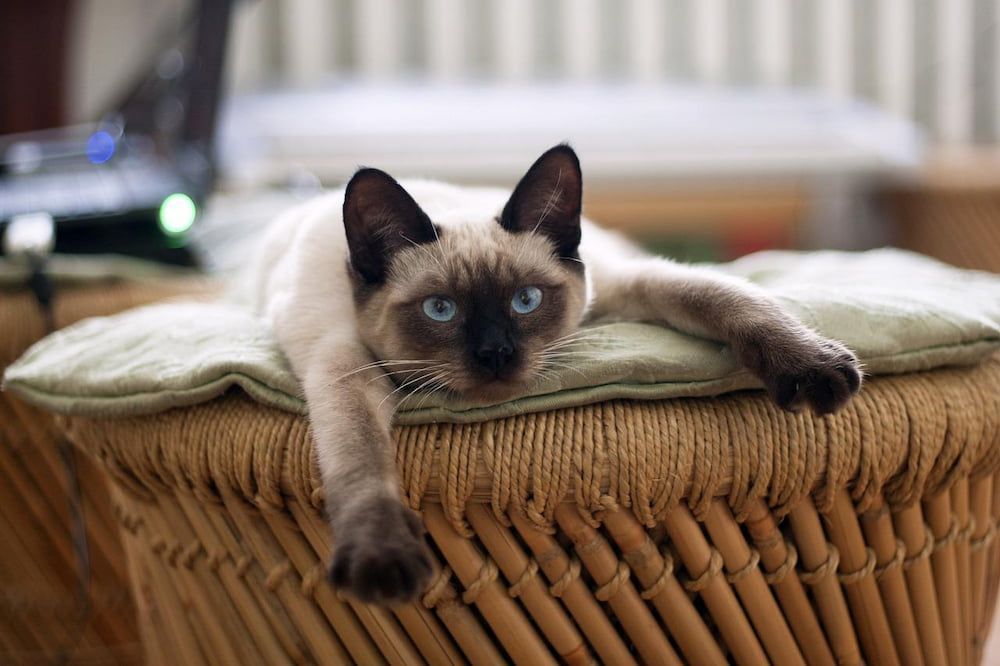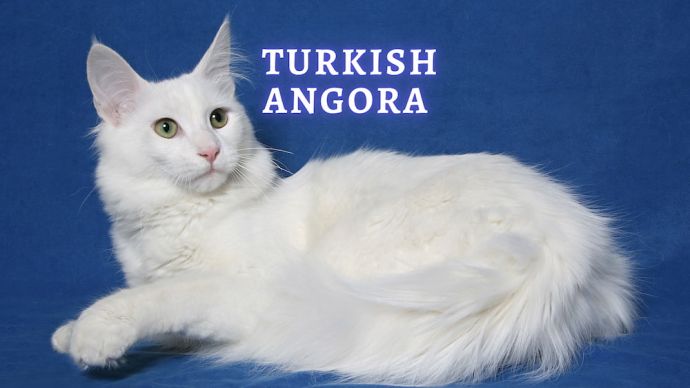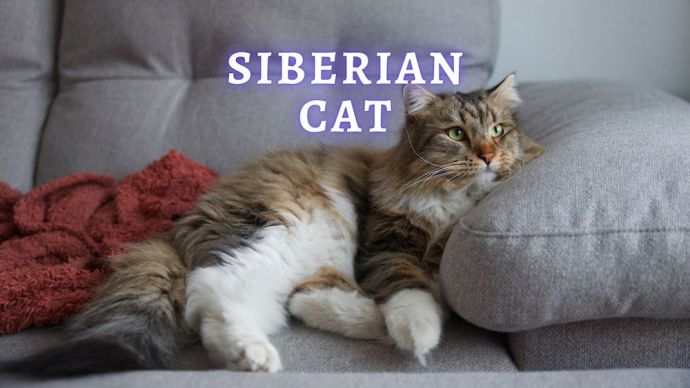Thai Cat: Thai Cat Breed History, Personality and Care
Written by:
Author: Vicki Smirnova
Vicki Smirnova is a professional writer and editor who adores animals and helps readers get along well with their pets. She has been working in digital media for more than 5 years and has great experience writing content about lifestyle, including pets. Vicki specializes in dog health and nutrition, cat feeding, dog training. She is an aquarium lover and is passionate to write about fish care at home. Also, Vicki headed several websites and worked as a news editor.
View all 244 articlesLearn about our editorial process and veterinary review board.
Viewed: 96
Updated on: 12/22/2022
Thai cats are an ancient breed and are the progenitor of Siamese cats. Many years of felinologists’ work have changed the original appearance of the Thai – the head began to have a wedge-shaped form, the ears became larger, the paws became more elongated, and the general image became more refined. But the original beauty of the Siamese breed was preserved, and thanks to them, we have Thai cats today.
Characteristics
| Weight | 7-12 pounds |
| Height | medium |
| Colors and patterns | tortie point, torbie point, and tabby point |
| Lifespan | 12-15 years |
| Suitable for | families looking for an active, playful cat |
READ MORE: All About the Seal Point Siamese
Breed History
The first depiction of a Thai-type cat was found in 14th-century manuscripts held at the National Laboratory in Bangkok. These animals lived at Buddhist temples, and Emperors liked them very much, and only in the 19th century were they brought to Europe. Officially, the cat was recognized at the end of the 20th century, then the standard of the animal was approved.
Siamese of thSiamese of the late 19th and early 20th centuries looked similar. The first Siamese came from Asia to Europe (1884) and then to America (after 1920). Almost immediately, intensive breeding of this exotic cat began. As a result of selection work, the appearance of the Siamese started to change and acquire an extremely refined cat with a wedge-shaped head, large ears, and high, slender, elegant paws. The old type of this breed has been preserved, thanks to lovers of the past exterior. Thus, Siamese are the descendants of Thais.[1]
RELATED: Best Cat DNA Tests: Cat Genetic Testing (Review)
Interesting Facts
- They need to have the annoying habit of marking their territory.
- Independent, graceful, and very smart.
- A distinctive feature is a color: eight dark markings and sky-blue eyes.
- Very emotional and talkative.
- A Siamese descendent; retained the old type exterior: round head, muscular body, and medium paws.
- One of the world’s most ancient breeds, they are excellent nannies for children.
Temperament and Personality
Thai cats are susceptible to their owners and easily guess the mood and adapt. If you are sad, the pet will try to give you affection and care with its peaceful purring. The most important thing is never to show aggression because the Thais are pretty vindictive.
Such cats prefer active games to a quiet pastime with the owner on the couch. They quickly get along with other family members and pets and know how to connect even with small children.
Thais can talk in various intonations and sound perfectly characteristic of its state – they will come to thank you for a delicious dinner or express its displeasure with a long absence. At the same time, the Thai cat is also sensitive to the owner’s mood – it can come to support you at the right time or, conversely, leave you alone.
| All Around Friendliness | 4.5 out of 5 |
| Affectionate with family | 5 out of 5 |
| Children friendly | 5 out of 5 |
| Dog-friendly | 4 out of 5 |
| Cat friendly | 4 out of 5 |
| Health and Grooming | 4 out of 5 |
| Amount of shedding | 4 out of 5 |
| Easy to groom | 4 out of 5 |
| General Health | 4 out of 5 |
| Trainability | 5 out of 5 |
| Intelligence | 5 out of 5 |
| Activity | 5 out of 5 |
| Energy level | 5 out of 5 |
| Intensity | 5 out of 5 |
| Exercise needs | 4 out of 5 |
The breed standard approved in 1991 is currently under revision, so the breed is considered open. This means that any animal similar in phenotype to a Thai cat can be assigned to the breed. To confirm such affiliation, it is necessary to have two expert signatures on the registration documents. Such animals are then allowed for official breeding.
The Thai’s head is rounded, without pronounced angularities and flat fragments. The forehead is moderately convex, and the transition to the nose is clearly marked and leveled with the eyes. The muzzle is clearly marked, and the cheeks are round (in adult animals, they are clearly defined). Excessive plumpness is considered a disadvantage. The nose is of medium length and straight.
The eyes of Thai cats are large and slightly slanted (almond or lemon-shaped). The color of the iris is the sky blue to blue, and a saturated shade is valued higher. Round or excessively slanted eyes lower the judges’ scores.
The ears of Thais are medium, with a broad base and rounded tips, are located widely, and are characterized by little versatility.
The body of the Thai cat is dense and muscular but not massive. The chest is broad, and the limbs are of medium length and in proportion to the size of the body, which is solid and muscular. The paws are rounded and small; the tail (which is not long) is thick at the base and slightly tapers towards the tip.
The coat of the Thai cat is thin, short, smooth to the touch, and well attached to the skin but not “flat.”
The determining factor in the breed’s phenotype is contrasting dark shade (paws, muzzle, and tail). The leading tone’s gamma suggests the mask’s and limb’s corresponding colors. Dark hair on other parts of the animal’s body, as well as visible light hairs or light spots on the points, is a disqualifying factor. [2]
READ MORE: Most Affectionate Cat Breeds
Activity and Care
These pets are curious and playful. Thais love to explore familiar and new territories, jump and do acrobatics. It is essential to properly direct the energy of such a pet, so it does not get boring. The Thai cat can learn surprisingly quickly. These pets love to play with a rubber mouse or a ball. Excessive activity can lead to unpleasant domicile consequences or harm to the pet’s health.
From early childhood, a cat must be taught to use a tray, a scratching post, and rules of decency, such as not stealing from the table or damaging furniture. Some owners of Thai cats notice that their animals respond to dog commands. The primary rule here is to remain calm, exercise the cat regularly, and reward its merits. Do not anger your cat – give it only patience and love.
Thai cats are a fairly clean breed, so they won’t require much grooming. To care for wool, purchase a special brush. Brushing a cat is enough once every couple of weeks. Thais don’t like to bathe, so take them to the bath tub only if absolutely necessary: in case of heavy pollution or to prepare for an exhibition.
It is necessary to accustom the cat to all hygiene procedures: cleaning the ears, trimming the claws and preventive examinations. Breeders usually teach kittens how to litter, but in a new home, you still need to show the location of the toilet. It is important to teach the cat to sharpen its claws on the scratching post: this way, you will save your nerves and furniture. Be sure the house is warm, as drafts make the fur of Thai cats darker; in addition, the cat can catch a cold.
For feeding, choose quality, ready-made food or make a natural food menu if you have time to cook for the cat. However, giving some products – including liver, seafood, algae and iodine – to a Thai cat is undesirable, as they cause darkening of the coat.
Rescue
While it may be difficult to find a purebred Thai cat in a shelter, you can try those that cater to all types of cats:
You can also try CatTime’s adoption page, which allows you to search for suitable cats by breed and zip code!
Breeders and Cost
KKittens with papers and pedigree will cost about $600 – $1200. Thai cats rarely suffer from any genetic disease; however, strabismus and tail kinks can be observed in appearance. Make sure it does not suffer these problems when purchasing a tiny kitten. Buy only from trusted breeders. Thai cats rarely but can carry diseases, such as liver amyloidosis, cardiomyopathy, mammary tumors and gingivitis. But, in most cases, these are only hereditary diseases.
Conclusions
Thais are an excellent choice for both singles and large families with children. The main thing is that enough attention is paid to the cat – without it, it will be bored and mischievous. For such pets, the presence of other cats in the house will not be a detriment.
Thai cats are not suitable for workaholics and busy people who are often not at home. These pets need to communicate with their beloved owner, and it will be especially bad for the cat if you are often sent on business trips.
Do not take such a cat if birds or rodents already live at home – the cat will consider them prey, and things may end in tragedy. Also, Thai cats are not recommended for allergy sufferers: it is better to look after a hairless cat. It is possible that you will get used to your pet, but no one gives guarantees of this.
FAQ
Is the Thai cat the same as the Siamese?
Thai cats are larger and more compact and their neck is shorter and the chest is wider. The paws of Siamese are long and thin and the front paws are shorter than the hind ones. The long, thin tail noticeably tapers towards the tip and resembles a whip. Thai pets have both paws and a tail shorter and thicker.
Are Thai cats friendly?
Thais have wonderful character: smart, loyal and very friendly. In this, they resemble dogs. Owners of Thai pets especially note the intelligence, which allows you to train them. Another distinguishing feature of the breed is being “talkative.”
What is the difference between a Thai and a Siamese?
The appearance of modern Thais coincides with the breed’s original appearance. The muzzle of the Thai cat has obvious differences – the Thai has a round muzzle and the Siamese has an elongated one. The shape of the eyes is also different: the Thai cat’s eyes are rounded, while the Siamese’s are pointed. The paws of the Thais are shorter and more powerful than those of the Siamese.
How much do Thai cats cost?
Thai/old-style Siamese cats cost between $600 – $1200.
Article Sources:
- “Old-Style Siamese Breeders List.” PREOSSIA Prestwick-Beresford Old-Style Siamese Association, oldstylesiamese.com/.
- Bydlinski, Penny, and Bob Schwartz. “Breed Standards.” Fédération Internationale Féline, fifeweb.org/wp/breeds/breeds_prf_stn.php.
 Cat Breeds Norwegian Forest Cat vs. Maine Coon: What are Their Similarities and Differences?
Cat Breeds Norwegian Forest Cat vs. Maine Coon: What are Their Similarities and Differences? - 162
- 0
 Cat Care Why Does My Cat Attack My Legs? 10 Reasons Why and What To Do About It (Vet-Approved Advice)
Cat Care Why Does My Cat Attack My Legs? 10 Reasons Why and What To Do About It (Vet-Approved Advice) - 46013
- 21
 Cat Veterinary Tips Cat Stomach Gurgling: Vet Advice on Why is Your Cat Stomach Gurgling?
Cat Veterinary Tips Cat Stomach Gurgling: Vet Advice on Why is Your Cat Stomach Gurgling? - 36469
- 4
 Cat Veterinary Tips My Cat Lost its Voice: Can Cats get Laryngitis? (Vet Advice)
Cat Veterinary Tips My Cat Lost its Voice: Can Cats get Laryngitis? (Vet Advice) - 23554
- 13

























